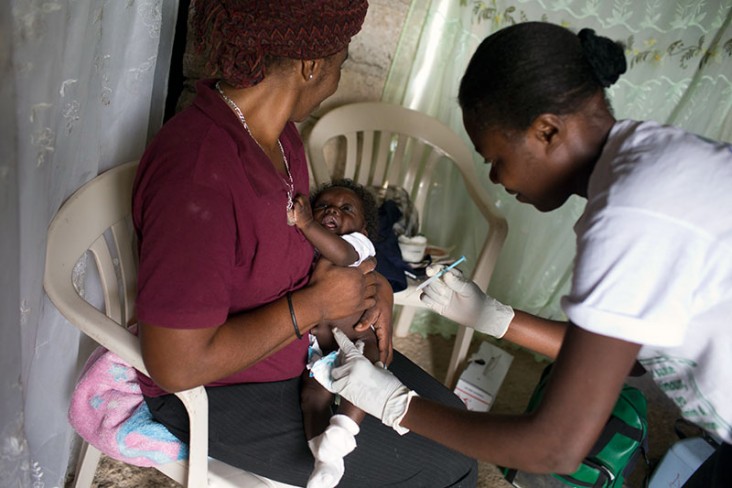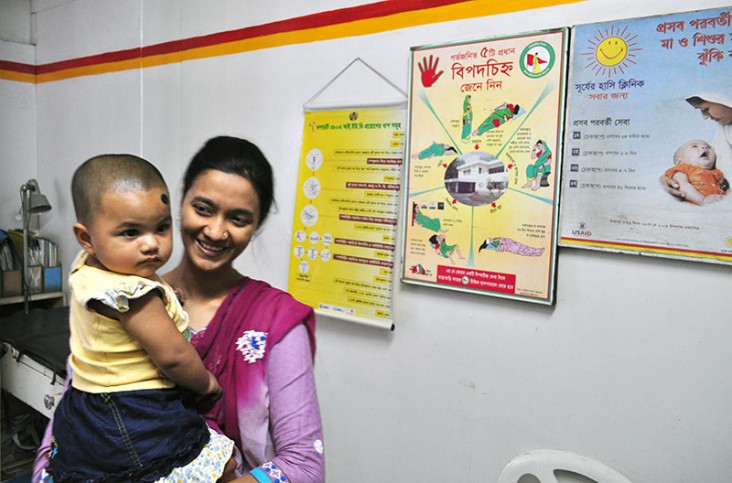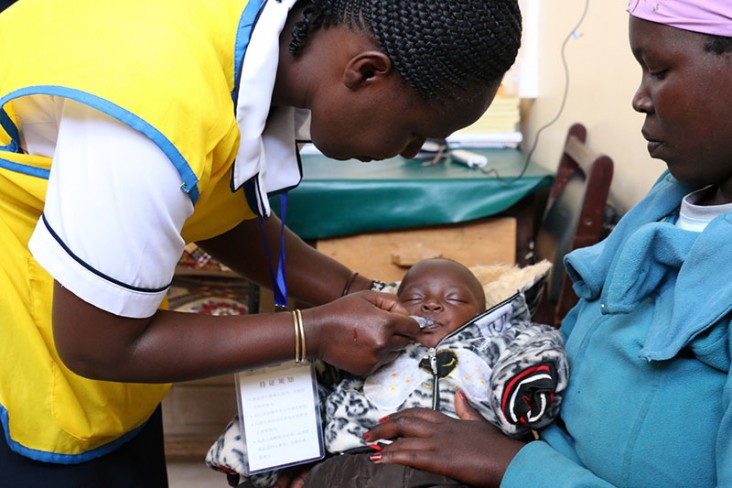- What We Do
- Agriculture and Food Security
- Democracy, Human Rights and Governance
- Economic Growth and Trade
- Education
- Ending Extreme Poverty
- Environment and Global Climate Change
- Gender Equality and Women's Empowerment
- Global Health
- Water and Sanitation
- Working in Crises and Conflict
- U.S. Global Development Lab

Immunization is one of the most cost-effective and lasting measures available to save a child's life.
Before being eradicated in 1979, Smallpox killed some 300 million people in the 20th century alone. Prior to widespread immunization, measles accounted for 2.6 million deaths each year. Polio, one of the most dreaded diseases in the United States as recently as 60 years ago, is closer than ever before to being eradicated worldwide – 2015 saw only 74 cases, down from 350,000 in 1988, preventing more than 10 million cases of childhood paralysis.
Vaccines convey a lifetime of protection to individuals and societies and contribute to healthy, productive populations. But, vaccines don't always reach the children who need them, and millions die as a result. In richer countries, vaccination is a scripted part of life for young children; however, immunizations in some poorer countries are still far from routine.
Immunization and Child Health
Vaccines have long been recognized as a cornerstone for child health and survival. With a 16-fold return on investment, immunization is among the most cost-effective health interventions, averting an estimated 2 to 3 million child deaths each year.
In priority countries, diphtheria-tetanus-pertussis (DPT3) coverage, a common indicator in the strength of a routine immunization system, increased from 71% in 2008 to 81% in 2015.
These estimates, however, mask deep inequalities in coverage both between and within countries, as 18.7 million infants worldwide – including 12.2 million infants in USAID's priority countries – are without basic vaccinations. The vast majority of these children live in Africa and South Asia. In addition, the introduction of new lifesaving vaccines in developing countries has generally lagged behind coverage in developed countries, even though poorer countries bear a disproportionate burden of diseases prevented by these vaccines, such as the rotavirus and pneumococcal conjugate vaccines.
USAID's Response
As a proven, effective public health intervention, immunization has been a priority for USAID development assistance for more than 3 decades. USAID works closely with partners around the world, including national governments, Gavi, The Vaccine Alliance, United Nations Children's Fund (UNICEF), the World Health Organization, the U.S. Centers for Disease Control and Prevention, and civil society organizations, to build strong routine immunization systems and extend equitable access to lifesaving vaccines to all. USAID's diverse portfolio of immunization programming supports the goals of the Global Vaccine Action Plan (GVAP), including extending equitable access to immunization to all and the development of new and improved vaccines and technologies, and contributes to the Agency's efforts to prevent child deaths.
Support for Gavi, The Vaccine Alliance. Since 2001, USAID has contributed $1.35 billion to Gavi, created to bring together the public and private sectors to support equal access to new and underutilized vaccines for children living in the world's poorest countries. USAID supports the accelerated introduction of new and underutilized vaccines in 73 Gavi-eligible countries. At the country level, USAID and its partners provide technical support for the introduction of new vaccines into routine immunization systems, and USAID has also supported a number of post-introduction evaluations and assessments. With support from USAID and others, Gavi has helped to vaccinate 500 million children and save 7 million lives since 2001.
In 2015, USAID pledged an additional $1 billion to Gavi over 4 years, subject to congressional approval, to immunize an additional 300 million children and save 5 million lives by 2020.
USAID engages in Gavi governance bodies at the global level and works in-country to support cooperation and collaboration of all Gavi partners. USAID's efforts help ensure that donor investments are strategically aligned and supportive of government priorities and programs. Engagement at the Gavi governance level allows for linking Gavi-specific engagement to broader USAID efforts, including primary health care systems strengthening, greater country ownership of health programs, and domestic resource mobilization.

Routine Immunization Systems Strengthening. USAID provides support to countries for strengthening routine immunization systems to create and sustain effective programs. USAID technical assistance to immunization system improvements protects and optimizes investments in Gavi and focuses on improving the effectiveness, efficiency, and equity of immunization programs worldwide.
At the national level, USAID provides support to countries through the development of sound immunization policy, strategies, and guidelines to ensure that routine immunization programs are well planned and well managed. USAID supports the introduction of new vaccines into national routine immunization programs as well as post-introduction evaluations and engages ministries of both health and finance to promote sustainable financing for immunization programs.
Other USAID activities focus on the implementation of innovative approaches and tools to expand the equitable access to immunization at subnational levels, developing creative, community-oriented, practical solutions to operational barriers. USAID supports the improvement of immunization managers' and providers' capacity through training and supportive supervision and works to strengthen supply chain management and information management systems. USAID participates in external immunization reviews and evaluations of immunization programs at national and subnational levels to further optimize and improve routine immunization systems at multiple levels of operation.
Support for Global Polio Eradication. USAID has been a key player in polio eradication activities since the beginning of the Global Polio Eradication Initiative (GPEI) and currently makes an annual contribution of $59 million toward polio eradication. USAID provides financial and technical assistance in support of polio endgame objectives, targeted to polio endemic countries, outbreak countries (especially for vaccine-derived virus), and countries at high risk of imported cases due to travel and cross-border activity. USAID's primary implementing partners are WHO, UNICEF and the CORE Group Polio Project (CGPP), and the majority of USAID support is directed toward surveillance and outbreak response, communication, social mobilization, and supplementary immunization activities. Additionally, USAID supports and participates in activities related to legacy planning, poliovirus containment, and certification, as well as global and regional polio advisory group meetings, surveillance reviews, and outbreak response assessments. USAID's approach also emphasizes engagement with local and international non-governmental organizations, and communities, with particular focus on hard-to-reach, mobile, cross-border, and refugee populations.
Vaccine Research and Development. USAID provides financial support for ongoing malaria vaccine research toward the development of three malaria vaccine approaches, targeting the parasite before and during liver stages and during the blood stage. USAID funding for HIV vaccine research and development focuses on candidate products that address the specific challenges faced by the low- and middle-income countries hardest hit by the HIV pandemic.
Examples of Our Work
In Kenya and Uganda, USAID assists district-level civil authorities in monitoring vaccination efforts and allocating the necessary resources for effective immunization strategies. These feedback mechanisms, overseen by key district-level decision-makers, have helped to build grassroots support for the effective application of local resources to cover recurrent operational costs – often neglected yet crucial to a sustainable immunization program. These costs include transportation to distribute vaccines, fuel for the refrigerators that store vaccines, outreach services to reach populations far from health facilities, and the supervision of health workers.

Elsewhere in Africa, USAID has launched programs specifically designed to reach vulnerable communities who lack regular access to immunization services. Programs in Nigeria and the Horn of Africa, covering Kenya, Somalia, and mobile populations along the borders of Djibouti, Ethiopia, and South Sudan, involve partnerships with more than 10 international non-governmental organizations and 20 local organizations. Launched in 2014, the project has engaged more than 10,000 community volunteers.
USAID works in numerous countries to identify effective approaches for improving community engagement and feedback around the immunization system. The USAID program My Village My Home has been used in India to improve immunization management, as well as community engagement in and support for immunization. The program makes use of an easy-to-construct visual display: a community health worker (CHW) draws the frame of a house on a piece of paper. After conducting a headcount of the community's children, the CHW draws a "plank" at the foundation of the house for each child and then shades in one plank for each child vaccinated. Just as more bricks make the foundation of a real home stronger, more vaccinated children make the community healthier. The illustration is meaningful to villagers and health workers alike and effectively conveys the importance of immunization, as well as the community's progress in vaccinating children.
RESOURCES
USAID Immunization fact sheet [PDF, 528KB]
Saving Lives Today, Saving Costs Tomorrow: Why USAID Invests in Immunization
Gavi: The Vaccine Alliance webpage
USAID Acting on the Call: Ending Preventable Child and Maternal Deaths







Comment
Make a general inquiry or suggest an improvement.